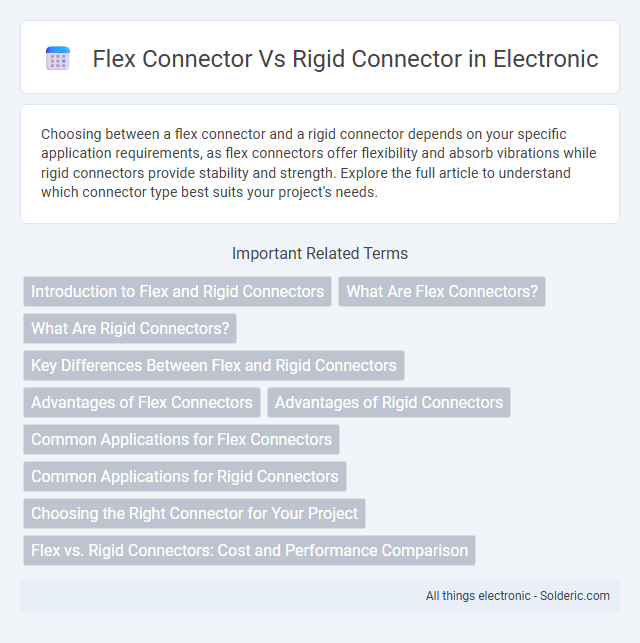Choosing between a flex connector and a rigid connector depends on your specific application requirements, as flex connectors offer flexibility and absorb vibrations while rigid connectors provide stability and strength. Explore the full article to understand which connector type best suits your project's needs.
Comparison Table
| Feature | Flex Connector | Rigid Connector |
|---|---|---|
| Material Flexibility | Flexible, allows movement and bending | Fixed, no flexibility |
| Application | Used in devices requiring motion or vibration absorption | Used in fixed, stable connections |
| Durability | Resistant to dynamic stress, but can wear over time | Highly durable under static conditions |
| Installation Ease | Easier to install in tight or moving spaces | Requires precise alignment and fixed mounting |
| Cost | Typically higher due to material and complexity | Generally lower cost |
| Electrical Performance | Good conductivity with flexibility | Excellent conductivity with stable connection |
Introduction to Flex and Rigid Connectors
Flex connectors offer adaptability and ease of installation by allowing movement and vibration absorption in electrical systems, making them essential for dynamic environments. Rigid connectors provide stable, secure, and permanent electrical connections ideal for fixed installations requiring durability and minimal maintenance. Your choice between flex and rigid connectors depends on the application's flexibility needs and mechanical stress tolerance.
What Are Flex Connectors?
Flex connectors are flexible plumbing or electrical components designed to absorb movement, vibrations, and thermal expansion between fixed points. Unlike rigid connectors, flex connectors use materials such as braided stainless steel, rubber, or flexible polymers to provide elasticity and ease of installation in tight or dynamic spaces. These connectors improve system durability and prevent leaks by accommodating shifts in piping or wiring setups.
What Are Rigid Connectors?
Rigid connectors are fixed electrical or mechanical components designed to establish a secure, stable connection without allowing movement or flexibility. They provide reliable conductivity and mechanical support in environments where vibration and motion are minimal or controlled. Your choice of rigid connectors ensures enhanced durability and consistent performance in high-load or precision applications.
Key Differences Between Flex and Rigid Connectors
Flex connectors offer superior flexibility and vibration resistance, making them ideal for applications requiring movement or alignment adjustments. Rigid connectors provide enhanced mechanical stability and durability, ensuring secure electrical connections in fixed installations. The choice between flex and rigid connectors depends on factors such as environmental conditions, mechanical stress, and installation requirements.
Advantages of Flex Connectors
Flex connectors offer superior flexibility and vibration absorption compared to rigid connectors, reducing stress on connected components and extending their lifespan. Their ease of installation in tight or dynamic spaces enhances maintenance efficiency and system reliability. You benefit from improved durability and reduced risk of leaks or mechanical failure in applications requiring movement or thermal expansion.
Advantages of Rigid Connectors
Rigid connectors offer exceptional stability and durability, making them ideal for applications requiring long-term structural integrity and minimal movement. Their solid construction ensures superior electrical conductivity and reduced maintenance compared to flexible counterparts. You benefit from enhanced safety and reliability in systems where vibration and bending are minimal.
Common Applications for Flex Connectors
Flex connectors are widely used in applications requiring vibration absorption, thermal expansion accommodation, and misalignment correction, such as HVAC systems, piping in industrial plants, and automotive exhaust systems. Their ability to flex and bend makes them ideal for connecting components subject to movement or thermal cycling, preventing damage and leaks. Common materials include stainless steel and rubber, selected based on temperature and pressure requirements.
Common Applications for Rigid Connectors
Rigid connectors are commonly used in structural frameworks, electrical conduit systems, and heavy machinery where stability and precise alignment are critical. Their solid construction allows for reliable support in building metal frameworks, HVAC duct installations, and industrial equipment connections. These connectors ensure minimal movement and high durability in environments requiring strong mechanical bonding.
Choosing the Right Connector for Your Project
Selecting the right connector depends on project requirements such as flexibility, durability, and installation environment, where flex connectors offer adaptability for movement and vibration absorption, while rigid connectors provide robust, stable connections ideal for fixed applications. Consider factors like electrical load, space constraints, and mechanical stress, as flex connectors excel in dynamic settings, whereas rigid connectors ensure consistent conductivity and minimal maintenance in stationary setups. Evaluating these specifications ensures optimal performance, safety, and longevity in electrical or mechanical systems.
Flex vs. Rigid Connectors: Cost and Performance Comparison
Flex connectors offer greater flexibility and vibration resistance, making them ideal for applications requiring frequent movement or adjustments, while rigid connectors provide superior durability and strength for fixed installations. Cost-wise, flex connectors generally come at a higher price due to their specialized materials and design, whereas rigid connectors are more affordable and easier to install. Performance-wise, flex connectors excel in dynamic environments, while rigid connectors deliver consistent conductivity and long-term reliability in static settings.
Flex connector vs Rigid connector Infographic

 solderic.com
solderic.com